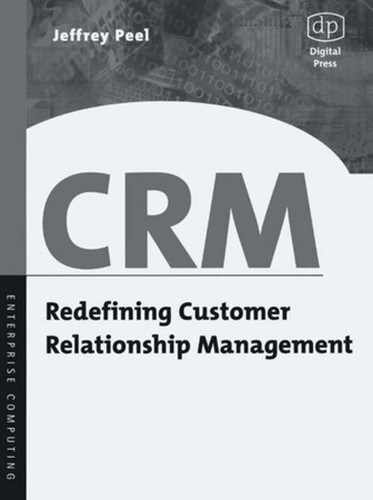
164 10,8 Defining the optimal customer
10.8
Similarly, to borrow that well-worn stockbroker's phrase, past perform-
ance is no guarantee of future performance, and that cuts both ways.
Customers who have spent well in the past may not spend well in the future.
A better method of ensuring long-term profitable customers, in my view,
is not to put in place cumbersome data warehouse solutions that attempt to
define long-term customer value. Rather, it is more appropriate to define the
nature of the ideal customer relationship and then nurture that relationship
through the effective CRM processes outlined earlier in this chapter and in the
previous chapter.
Let me explain in a little more detail what I mean. In this book, we have
emphasized communication as the key CRM focus. Traditionally, the process
of communication was in the domain of the marketing function. However, as
discussed elsewhere, we are seeing a move away from mass marketing toward
more formalized processes for customer acquisition and retention. It follows,
therefore, that there is little point in acquiring customers who fall short of the
customer type that is defined as optimal in terms of the product or service
bundle offered.
Let's take a banking example again. Most banks, retail banks, try to attract
customers using mass-marketing techniques. They advertise. They use direct
mail. They rarely, I would suggest, put much thought into the types of cus-
tomers they really want. Some, by default, attract lower net worth customers.
Others attract broad swaths of the midmarket. Certain private client banks
focus entirely on customers who might be considered high net worth.
All of these banks, however, probably attempt to sell similar products to
their customer bases (if at different price points). They will offer check
accounts, mortgages, loans, and retirement plans. They promote products
appropriately depending on their target market. However, they rarely seek to
describe their optimal customers.
Defining the optimal customer
Research can help to describe optimal customers. If these banks have estab-
lished relationships with customers, it should be relatively easy to identify
customers who represent the ideal type of relationship. They may be custom-
ers who have consistency in terms of revenue generation. They may be
customers who have embraced lower-cost communication channels. They
may be customers who react most well to communications campaigns and
seem most in tune and most engaged with the bank's brand values.

10.8 Defining the optimal customer 165
Research, qualitative and quantitative, within these customer segment,
can help the bank break down its offer for these target groups into its compo-
nent parts--using some of the techniques outlined previously. It can also
define how the bank should structure its customer data management so that
these optimal relationships can be nurtured.
Once the nature of the optimal customer relationship has been defined,
accounting principles can be applied to allow the bank to understand the
nature of these relationships at a cost and profit level. Management account-
ants use a technique called activity-based costing to determine, by reference to
a workflow, the absorbed costs at the product level and the resultant profit-
ability attributable to each product--assuming certain price points. This
approach can be tweaked for CRM purposes by looking at a defined optimal
customer and then looking at the input costs required to service each--based
on empirical evidence. Therefore, if the nature of the optimal customer rela-
tionship can be costed in this way, and revenue is known, profitability by
customer type can be ascertained. If the longevity of the relationship can be
assumed, based on past experience, future revenues can be discounted to pro-
duce a net present value for these optimal customers.
At an aggregate level, input costs will vary, of course, depending on how
successful the bank is in terms of acquiring optimal customers and losing
unprofitable or suboptimal customers. As customer numbers grow, there will
be concomitant rises in support costs to service them. Invariably, support
costs rise in increments at certain levels--to allow for new contact centers to
be constructed, for example. The degree of infrastructure costs that the bank
can absorb is all part of its budgeting process, so it should be possible for the
bank to define what level of customer acquisition is required, and what sup-
port costs will be required to service a certain optimal customer load.
Needless to say, this is hardly a common method of business planning in
most organizations. Customer support planning in most organizations is at
the level of broad and sweeping input costs. However, planning in this man-
ner-in terms of optimal customer acquisition and maintenance--is gaining
in popularity.
Having defined the optimal customer numbers and the CRM processes
that will be used to nurture them, it then becomes important to ensure that all
of those key metrics (at a microlevel) outlined earlier in the chapter, are
tracked over time. However, we are assuming, of course, that getting those
optimal customers and discouraging suboptimal customers is going to be easy.
This is not the case. Because the problem with optimal customers is that they
I Chapter 10
..................Content has been hidden....................
You can't read the all page of ebook, please click here login for view all page.
